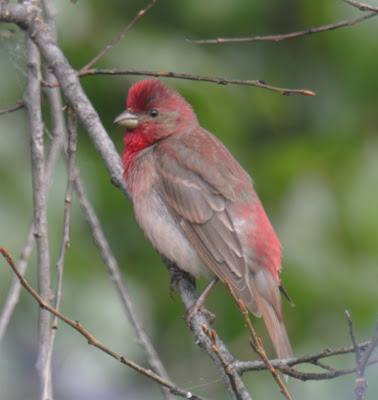Starting on the coast, we saw a small group of Red-necked Grebes (Podiceps grisegena). They have a global distribution: one sub-species extends from eastern Europe to Russia and the far east, the other is found in the north of America. The joy of them is when, in summer, they turn from a dull grey to sport a bright red neck.
A White-tailed Eagle (Haliaeetus albicilla) flew over the sea in search of fish or water birds. They are happy fishing in northern waters, from the Baltic to Japan, though they do go to southern Asia to escape the Siberian winters. They were shot and poisoned to extinction in Britain by 1916 - but there is now a sucessful reintroduction programme. They are big fearsome birds, with a wingspan that can reach almost 2.5 metres and with a bill almost half of the head.
Into the woods, and we found an active nest of the White-backed Woodpecker (Dendrocopos leucotos). They were first described in 1802 by the German naturalist Johann Matthäus Bechstein - an early conservationist - and can be found from eastern Europe through to Japan. We had very close views of a male going out to collect food and bringing it back to the chicks.
The male of a Common Rosefinch (Carpodacus erythrinus) is only rivalled for redness in Europe by the Crossbills. We think of them as birds of north-east Europe - but they occur as far east as Japan, and as far south as India and south-east Asia.When Rosefinches are caught in a certain light, they can positively glow.
BBC - still listening after all these years. Terviseks!
The Pied Flycatcher (Ficedula hypoleuca) is really a European species, though it spends its winters in West Africa. They have been studied a lot due to the males' habit of bigamy. They may set up two nests with consecutive females, but only look after the nest of the first - and the second females will only rear half the number of offspring due to this neglect. Why the second females accept this is unclear - it may be that the fewer males they rear inherit the advantagous mate finding genes of their fathers, or the females compete for mates and settle for what they can get; or the females are simply deceived. Whatever, ornithologists are advised not to try this at home!
Warblers are often called by birders LBJs ('little brown jobs'). They often lack the bright colours of other birds, and may be difficult to see as they skulk around in foliage like little mice. And species are often difficult to tell apart. This is a Whitethroat (Sylvia communis), an LBJ with a WT. Sylvia warblers are usually sturdy, the males with contrasting dark heads, and they prefer to live in dense thickets.
Phylloscopus warblers are often tinged with green and yellow with a pale supercilium ('eyebrow'), and will flit about trees and sit on their tops. I think this is a Willow Warbler (Phylloscopus trochilus). It is very similar to the Chiffchaff, but has paler legs.
This also looks like a Willow Warbler, but it is darker in body and legs. There is a hint of a pale bar on its side, which could make it a Greenish Warbler (Phylloscopus trochiloides) - but it is only a hint. So it is most probably a Chiffchaff (Phylloscopus collybita) of the abietinus sub-species, found in Scandinavia and Russia.
In the reeds a Sedge Warbler (Acrocephalus schoenobaenus). Acrocephalus warblers may also have pale 'eyebrows', but they have a more pointed shape and live in marshlands.
The Marsh Warbler (Acrocephalus palustris) looks very similar to the Reed Warbler - though it tends to have paler legs, and prefers woody plants to reeds.
Birding is not just about looking, and most people's experience of birds is listening to them sing. Warblers are great singers, and their song can be used to identify them when a good view is not possible. All the above warblers are migratory, spending the winter in Africa - and one of the joys of Spring is listening to them sing again on their return. I'll leave you with our Estonian Marsh Warbler singing in the midst of a chorus of song. He has a different call to the similar Reed Warbler - but is also known to copy the songs of other species. LBJs - never easy!We saw around 100 species of birds in Estonia. Some actic breeders - such as the Great Snipe, Redwings, Whooper Swans, Golden Plovers and Greenish Warblers - had reached their most southerly breeding sites after migration. That included Arctic Terns, which spend the rest of the year circumnavigating the globe. Others, such as the Barnacle Geese and White-fronted Geese, were just pausing on their way further north.


















No comments:
Post a Comment